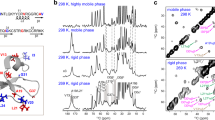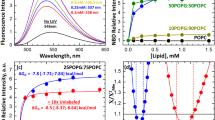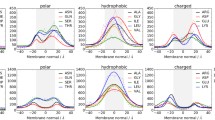Abstract
Previous simulations showed that the β-hairpin antimicrobial peptide (AMP) protegrin-1 can form stable octameric β-barrels and tetrameric arcs (half barrels) in both implicit and explicit membranes. Here, we extend this investigation to several AMPs of similar structure: tachyplesin, androctonin, polyphemusin, gomesin, and the retrocyclin θ-defensin. These peptides form short β-hairpins stabilized by 2–3 disulfide bonds. We also examine synthetic β-sheet peptides selected from a combinatorial library for their ability or inability to form pores in lipid membranes. When heptameric, octameric, and decameric β-barrels and tetrameric arcs of these peptides were embedded in pre-formed neutral or anionic lipid pores (i.e., pores in neutral or anionic membranes, respectively), a variety of behaviors and membrane binding energies were observed. Due to the cationic charge of the peptides, more favorable transfer energies and more stable binding were observed in anionic than neutral pores. The synthetic peptides bound very strongly and formed stable barrels and arcs in both neutral and anionic pores. The natural AMPs exhibited unfavorable or marginally favorable binding energy and kinetic stability in neutral pores, consistent with the lower hemolytic activity of some of them compared with protegrin-1. Binding to anionic pores was more favorable, but significant distortions of the barrel or arc structures were sometimes noted. These results are discussed in light of the available experimental data. The diversity of behaviors obtained makes it unlikely that the barrel and arc mechanisms are valid for the entire family of β-hairpin AMPs.







Similar content being viewed by others
References
Baker NA, Sept D, Joseph S, Holst MJ, McCammon JA (2001) Electrostatics of nanosystems: Application to microtubules and the ribosome. Proc Natl Acad Sci USA 98:10037–10041
Bechinger B (2004) Structure and function of membrane-lytic peptides. Crit Rev Plant Sci 23:271–292
Ben-Tal N, Honig B, Peitzsch RM, Denisov G, McLaughlin S (1996) Binding of small basic peptides to membranes containing acidic lipids: theoretical models and experimental results. Biophys J 71:561–575
Bolintineanu DS, Kaznessis YN (2011) Computational studies of protegrin antimicrobial peptides: a review. Peptides 32:188–201
Boughton AP, Nguyen K, Andricioaei I, Chen Z (2011) Interfacial orientation and secondary structure change in tachyplesin I: molecular dynamics and sum frequency generation spectroscopy studies. Langmuir 27:14343–14351
Bradshaw JP (2003) Cationic antimicrobial peptides. Issues for potential clinical use. Biodrugs 17:233–240
Brogden K (2005) Antimicrobial peptides: Pore formers or metabolic inhibitors in bacteria? Nat Rev Microbiol 3:238–250
Brooks BR, Brooks CL III, MacKerrel AD Jr, Nilsson L, Petrella RJ et al (2009) CHARMM: The biomolecular simulation program. J Comput Chem 30:1545–1614
Brown KL, Hancock REW (2006) Cationic host defense (antimicrobial) peptides. Curr Opin Immunol 18:24–30
Capone RM, Mustata M, Jang H, Arce FT, Nussinov R, Lal R (2010) Antimicrobial protegrin-1 forms ion channels: molecular dynamic simulation, atomic force microscopy, and electrical conductance studies. Biophys J 98:2644–2652
Chen J, Falla TJ, Liu H, Hurst MA, Fujii CA et al (2000) Development of protegrins for the treatment and prevention of oral mucositis: structure–activity relationships of synthetic protegrin analogues. Biopolymers 55:88–98
Cole AM (2005) Antimicrobial peptide microbicides targeting HIV. Protein Pept Lett 12:41–47
Doherty T, Waring AJ, Hong M (2006) Membrane-bound conformation and topology of the antimicrobial peptide tachyplesin I by solid-state NMR. Biochemistry 45:13323–13330
Domingues TM, Riske KA, Miranda A (2010) Revealing the lytic mechanism of the antimicrobial peptide gomesin by observing giant unilamellar vesicles. Langmuir 26:11077–11084
Ehret-Sabatier L, Loew D, Goyffon M, Fehlbaum P, Hoffmann JA et al (1996) Characterization of novel cysteine-rich antimicrobial peptides from scorpion blood. J Biol Chem 271:29537–29544
Eisenberg D, Schwarz E, Komarony M, Wall R (1984) Amino acid scale: normalized consensus hydrophobicity scale. J Mol Biol 179:125–142
Fahrner RL, Dieckmann T, Harwig SSL, Lehrer RI, Eisenberg D, Feigon J (1996) Solution structure of protegrin-1, a broad-spectrum antimicrobial peptide from porcine leukocytes. J Chem Biol 3:543–550
Fázio MA, Oliveira VX, Bulet P, Miranda MTM, Daffre S, Miranda A (2006) Structure–activity relationship studies of gomesin: importance of the disulfide bridges for conformation, bioactivities, and serum stability. Pept Sci 84:205–218
Fázio MA, Jouvensal L, Vovelle F, Bulet P, Miranda TM et al (2007) Biological and structural characterization of new linear gomesin analogues with improved therapeutic indices. Pept Sci 88:386–400
Gille C (2012) STRAP: interactive structure based sequences alignment program. Institut für Biochemie, Charité Berlin. http://www.bioinformatics.org/strap/index2.html. Accessed 7 Nov 2014
Hancock REW (2001) Cationic peptides: effectors in innate immunity and novel antimicrobials. Lancet Infect Dis 1:156–164
He Y, Lazaridis T (2013) Activity determinants of helical antimicrobial peptides: a large-scale computational study. PLoS ONE 8(6):e66440
He Y, Prieto L, Lazaridis T (2013) Modeling peptide binding to anionic membrane pores. J Comput Chem 34:1463–1475
Heller WT, Waring AJ, Lehrer RI, Huang HW (1998) Multiple states of β-sheet peptide protegrin in lipid bilayers. Biochemistry 37:17331–17338
Hetru C, Letellier L, Oren Z, Hoffmann JA, Shai Y (2000) Androctonin, a hydrophilic disulphide-bridged non-haemolytic anti-microbial peptide: a plausible mode of action. Biochem J 345:653–664
Huang HW (2000) Action of antimicrobial peptides: two-state model. Biochemistry 39:8347–8352
Huang HW (2006) Molecular mechanism of antimicrobial peptides: the origin of cooperativity. Biochim Biophys Acta 1758:1292–1302
Humphrey W, Dalke A, Schulten K (1996) VMD—visual molecular dynamics. J Mol Graph 14:33–38
Ishitsuka Y, Pham DS, Waring AJ, Lehrer RI, Lee KYC (2006) Insertion selectivity of antimicrobial peptide protegrin-1 into lipid monolayers: effect of head group electrostatics and tail group packing. Biochim Biophys Acta 1758:1450–1460
Jang H, Ma B, Woolf TB, Nussinov R (2006) Interaction of protegrin-1 with lipid bilayers: membrane thinning effect. Biophys J 91:2848–2859
Jang H, Ma BY, Nussinov R (2007) Conformational study of the protegrin-I (PG-I) dimer interaction with lipid bilayers and its effect. BMC Struct Biol 7:20
Jang H, Ma B, Lal R, Nussinov R (2008) Models of toxic beta-sheet channels of protegrin-1 suggest a common subunit organization motif shared with toxic Alzheimer beta-amyloid ion channels. Biophys J 95:4631–4642
Jang H, Teran Arce F, Ramachandran S, Capone R, Lal R, Nussinov R (2010) Structural convergence among diverse, toxic β-sheet ion channels. J Phys Chem B 114:9445–9451
Kandasamy SK, Larson RG (2007) Binding modes of protegrin-1, a β-strand antimicrobial peptide, in lipid bilayers. Mol Simul 33:799–807
Katsu T, Nakao S, Iwanaga S (1993) Mode of action of an antimicrobial peptide, tachyplesin I, on biomembranes. Bio Pharm Bull 16:178–181
Khandelia H, Kaznessis YN (2007) Structure of the antimicrobial β-hairpin peptide protegrin-1 in a DLPC lipid bilayer investigated by molecular dynamics simulation. Biochim Biophys Acta 1768:509–520
Kokryakov VN, Harwig SSL, Panyutich EA, Shevchenko AA, Aleshina GM et al (1993) Protegrins: leukocyte antimicrobial peptides that combine features of corticostatic defensins and tachyplesins. FEBS Lett 327:231–236
Laederach A, Andreotti AH, Fulton DB (2002) Solution and micelle-bound structures of tachyplesin I and its active aromatic linear derivatives. Biochemistry 41:12359–12368
Lai JR, Epand RF, Weisblum B, Epand RM, Gellman SH (2006) Roles of salt and conformation in the biological and physicochemical behavior of protegrin-1 and designed analogues: Correlation of antimicrobial, hemolytic, and lipid bilayer-perturbing activities. Biochemistry 45:15718–15730
Lam KLH, Wang H, Siaw TA, Chapman MR, Waring AJ, Kindt JT, Lee KYC (2012) Mechanism of structural transformations induced by antimicrobial peptides in lipid membranes. Biochim Biophys Acta Biomembr 1818:194–204
Langham AA, Kaznessis YN (2006) Effects of mutations on the C-terminus of protegrin-1: a molecular dynamics simulation study. Mol Simul 32:193–201
Langham AA, Ahmad AS, Kaznessis YN (2008) On the nature of antimicrobial activity: a model for protegrin-1 pores. J Am Chem Soc 130:4338–4346
Lazaridis T (2003) Effective energy function for proteins in lipid membranes. Proteins 52:176–192
Lazaridis T (2005a) Implicit solvent simulations of peptide interactions with anionic lipid membranes. Proteins 58:518–527
Lazaridis T (2005b) Structural determinants of transmembrane beta-barrels. J Chem Theory Comput 1:716–722
Lazaridis T, Karplus M (1999) Effective energy function for proteins in solution. Proteins 35:133–152
Lazaridis T, He Y, Prieto L (2013) Membrane interactions and pore formation by the antimicrobial peptide protegrin. Biophys J 104:633–642
Lehrer RI, Cole AM, Selsted ME (2012) Theta-defensins: cyclic peptides with endless potential. J Biol Chem 287:27014–27019
Leontiadou H, Mark AE, Marrink SJ (2006) Antimicrobial peptides in action. J Am Chem Soc 128:12156–12161
Lerner MG, Carlson HA (2009) PyMOL APBS tools. http://www.pymolwiki.org/index.php/Apbs. Accessed 7 Nov 2014
Ludtke SJ, He K, Heller WT, Harroun TA, Yang L, Huang HW (1996) Membrane pores induced by magainin. Biochemistry 35:13723–13728
Mandard N, Sy D, Maufrais C, Monmatin JM, Bulet P et al (1999) Androctonin, a novel antimicrobial peptide from scorpion Androctonus australis: solution structure and molecular dynamics simulations in the presence of a lipid monolayer. J Biomol Struct Dyn 17:367–380
Mandard N, Labbe H, Da Silva P, Hetru C, Landon C, Vovelle F (2001) Role of disulfide bridges in the hairpin fold of androctonin. Structure–activity relationships. C R Acad Sci Ser Fasc C 4:735–738
Mandard N, Bulet P, Caille A, Daffre S, Vovelle F (2002) The solution structure of gomesin, an antimicrobial cysteine-rich peptide from the spider. Eur J Biochem 269:1190–1198
Mangoni ME, Aumelas A, Charnet P, Roumestand P, Chiche L et al (1996) Change in membrane permeability induced by protegrin 1: implication of disulphide bridges for pore formation. FEBS Lett 383:93–98
Mani R, Cady SD, Tang M, Waring AJ, Lehrer RI, Hong M (2006) Membrane-dependent oligomeric structure and pore formation of beta-hairpin antimicrobial peptide in lipid bilayers from solid-state NMR. P Natl Acad Sci USA 103:16242–16247
Matsuzaki K (1999) Why and how are peptide–lipid interactions utilized for self-defense? magainins and tachyplesins as archetypes. Biochim Biophys Acta 1462:1–10
Matsuzaki K (2009) Control of cell selectivity of antimicrobial peptides. Biochim Biophys Acta 1788:1687–1692
Matsuzaki K, Murase O, Fujii N, Miyajima K (1996) An antimicrobial peptide, magainin 2, induced rapid flip-flop of phospholipids coupled with pore formation and peptide translocation. Biochemistry 35:11361–11368
Mihajlovic M, Lazaridis T (2010) Antimicrobial peptides bind more strongly to membrane pores. Biochim Biophys Acta 1798:1494–1502
Miyata T, Tokunaga F, Yoneya T, Yoshikawa K, Iwanaga S et al (1989) Antimicrobial peptides, isolated from horseshoe crab hemocytes, tachyplesin II, and polyphemusins I and II: chemical structures and biological activity. J Biochem 106:663–668
Mizuguchi M, Kamata S, Kawabata S, Fujitani N, Kawano K (unpublished) Solution structure of tachyplesin I in H2O. PDB 1WO0. doi:10.2210/pdb1wo0/pdb
Morein S, Andersson A-S, Rilfors L, Lindblom G (1996) Wild-type Escherichia coli cells regulate the membrane lipid composition in a “window” between gel and non-lamellar structures. J Biol Chem 271:6801–6809
Mottamal M, Lazaridis T (2006) Voltage-dependent energetics of alamethicin monomers in the membrane. Biophys Chem 122:50–57
Murzin AG, Lesk AM, Chothia C (1994) Principles determining the structure of beta-sheet barrels in proteins. I. A theoretical analysis. J Mol Biol 236:1369–1381
Oren Z, Shai Y (1998) Mode of action of linear amphipathic alpha-helical antimicrobial peptides. Biopolymers 47:451–463
Ostberg N, Kaznessis Y (2005) Protegrin structure-activity relationships: using homology models of synthetic sequences to determine structural characteristics important for activity. Peptides 26:197–206
Palermo EF, Vemparala S, Kuroda K (2012) Cationic spacer arm design strategy for control of antimicrobial activity and conformation of amphiphilic methacrylate random copolymers. Biomacromolecules 13:1632–1641
Papo N, Shai Y (2005) Host defense peptides as new weapons in cancer treatment. Cell Mol Life Sci 62:784–790
Paredes-Gamero EJ, Martins MNC, Cappabianco FAM, Ide JS, Miranda A (2012) Characterization of dual effects induced by antimicrobial peptides: regulated cell death or membrane disruption. Biochim Biophys Acta 1820:1062–1072
Penberthy WT, Chari S, Cole AL, Cole AM (2011) Retrocyclins and their activity against HIV-1. Cell Mol Life Sci 68:2231–2242
Powers JPS, Rozek A, Hancock REW (2004) Structure–activity relationships for the beta-hairpin cationic antimicrobial peptide polyphemusin I. Biochim Biophys Acta 1698:239–250
Powers JPS, Tan A, Ramamoorthy A, Hancock REW (2005) Solution structure and interaction of the antimicrobial polyphemusins with lipid membranes. Biochemistry 44:15504–15513
Prieto L, He Y, Lazaridis T (2014) Protein arcs may form stable pores in lipid membranes. Biophys J 106:154–161
Ramamoorthy A, Thennarasu S, Tan A, Gottipati K, Sreekumar S, Heyl DL et al (2006) Deletion of all cysteines in tachyplesin I abolishes hemolytic activity and maintains antimicrobial activity and lipopolysaccharide selective binding. Biochemistry 45:6529–6540
Ratledge C, Wilkinson SG (1988) Microbial Lipids, vol 1. Academic Press, London
Rausch JM, Marks JR, Wimley WC (2005) Rational combinatorial design of pore-forming β-sheet peptides. Proc Natl Acad Sci USA 102:10511–10515
Rausch JM, Marks JR, Rathinakumar R, Wimley WC (2007) β-sheet pore-forming peptides selected from a rational combinatorial library: mechanism of pore formation in lipid vesicles and activity in biological membranes. Biochemistry 46:12124–12139
Robinson JA, Shankaramma SC, Jetter P, Kienzl U, Schwendener RA et al (2005) Properties and structure–activity studies of cyclic b-hairpin peptidomimetics based on the cationic antimicrobial peptide protegrin I. Bioorg Med Chem 13:2055–2064
Roumestand C, Louis V, Aumelas A, Grassy G, Calas B, Chavanieu A (1998) Oligomerization of protegrin-1 in the presence of DPC micelles. A proton high-resolution NMR study. FEBS Lett 421:263–267
Rui HA, Im W (2010) Protegrin-1 orientation and physicochemical properties in membrane bilayers studied by potential of mean force calculations. J Comput Chem 31:2859–2867
Rui H, Lee J, Im W (2009) Comparative molecular dynamics simulation studies of protegrin-1 monomer and dimer in two different lipid bilayers. Biophys J 97:787–795
Schrödinger LLC (2014) The PyMOL Molecular Graphics System, Version 1.7. Schrödinger LLC
Selsted ME (2004) θ-Defensins: cyclic antimicrobial peptides produced by binary ligation of truncated α-defensins. Curr Protein Pept Sci 5:365–371
Sengupta D, Leontiadou H, Mark AE, Marrink SJ (2008) Toroidal pores formed by antimicrobial peptides show significant disorder. Biochim Biophys Acta 1778:2308–2317
Silphaduang U, Noga EJ (2001) Peptide antibiotics in mast cells of fish. Nature 414:268–269
Silva PI, Daffre S, Bulet P (2000) Isolation and characterization of gomesin, an 18-residue cysteine-rich defense peptide from the spider Acanthoscurria gomesiana hemocytes with sequence similarities to horseshoe crab antimicrobial peptides of the tachyplesin family. J Biol Chem 275:33464–33470
Sokolov Y, Mirzabekov T, Martin DW, Lehrer RI, Kagan BL (1999) Membrane channel formation by antimicrobial protegrins. Biochim Biophys Acta 1420:23–29
Soletti RC, del Barrio L, Daffre S, Miranda A, Borges HL et al (2010) Peptide gomesin triggers cell death through L-type channel calcium influx, MAPK/ERK, PKC and PI3 K signaling and generation of reactive oxygen species. Chem Biol Interact 186:135–143
Steinberg DA, Hurst MA, Fujii CA, Kung AH, Ho JF et al (1997) Protegrin-1: a broad-spectrum, rapidly microbicidal peptide with in vivo activity. Antimicrob Agents Chemother 41:1738–1742
Tam JP, Wu CW, Yang JL (2000) Membranolytic selectivity of cystine-stabilized cyclic protegrins. Eur J Biochem 267:3289–3300
Tang M, Hong M (2009) Structure and mechanism of beta-hairpin antimicrobial peptides in lipid bilayers from solid-state NMR spectroscopy. Mol Biosyst 5:317–322
Tang Y-Q, Yuan J, Ösapay G, Ösapay K, Tran D et al (1999) A cyclic antimicrobial peptide produced in primate leukocytes by the ligation of two truncated & #x03B1;-defensins. Science 286:498–502
Thøgersen L, Schiøtt B, Vosegaard T, Nielsen NC, Tajkhorshid E (2008) Peptide aggregation and pore formation in a lipid bilayer: a combined coarse-grained and all atom molecular dynamics study. Biophys J 95:4337–4347
Trabi M, Schirra HJ, Craik DJ (2001) Three-dimensional structure of RTD-1, a cyclic antimicrobial defensin from rhesus macaque leukocytes. Biochemistry 40:4211–4221
Tran D, Tran P, Roberts K, Ösapay G, Schaal J et al (2008) Microbicidal properties and cytocidal selectivity of rhesus macaque theta defensins. Antimicrob Agents Chemother 52:944–953
Tran D, Tran PA, Tang YQ, Yuan J, Cole T, Selsted ME (2002) Homodimeric θ-defensins from rhesus macaque leukocytes. J Biol Chem 277:3079–3084
Verkleij AJ, Zwaal RFA, Roelofsen B, Comfurius P, Kastelijn D, Deenen LLMV (1973) The asymmetric distribution of phospholipids in the human red cell membrane. A combined study using phospholipases and freeze-etch electron microscopy. Biochim Biophys Acta 323:178–193
Vivcharuk V, Kaznessis Y (2010) Free energy profile of the interaction between a monomer or a dimer of protegrin-1 in a specific binding orientation and a model lipid bilayer. J Phys Chem B 114:2790–2797
Vivcharuk V, Kaznessis Y (2011) Thermodynamic analysis of protegrin-1 insertion and permeation through a lipid bilayer. J Phys Chem B 115:14704–14712
Wessely-Szponder J, Majer-Dziedzic B, Smolira A (2010) Analysis of antimicrobial peptides from porcine neutrophils. J Microbiol Methods 83:8–12
Yang L, Harroun TA, Weiss TM, Ding L, Huang HW (2001) Barrel-stave model or toroidal model? A case study on melittin pores. Biophys J 81:1475–1485
Zhan H, Lazaridis T (2012) Influence of the membrane dipole potential on peptide binding to lipid bilayers. Biophys Chem 161:1–7
Zhan H, Lazaridis T (2013) Inclusion of lateral pressure/curvature stress effects in implicit membrane models. Biophys J 104:643–654
Zhang L, Scott MG, Yan H, Mayer LD, Hancock REW (2000) Interaction of polyphemusin I and structural analogs with bacterial membranes, lipopolysaccharide, and lipid monolayers. Biochemistry 39:14504–14514
Acknowledgments
Funding for this research was provided by the National Science Foundation (MCB 1244207). Infrastructure support was provided in part by RCMI grant 2G12RR03060-26A1/8G12MD007603-27 from the National Institutes of Health. No human or animal studies were carried out by the authors for this article. Authors RBL and TL declare that they have no conflict of interest.
Author information
Authors and Affiliations
Corresponding author
Electronic Supplementary Material
Online Resource 1 Average total effective energies (<W>; kcal/mol) and membrane transfer energies (<ΔW>; kcal/mol) of octamer barrels and tetramer arcs of peptides from water to toroidal pores of R o = 10, 12, and 15 Å (k = 15 Å) from 2-ns simulations. Description of the behavior of all octamer β-barrels and tetramer arcs during these simulations.
Rights and permissions
About this article
Cite this article
Lipkin, R.B., Lazaridis, T. Implicit Membrane Investigation of the Stability of Antimicrobial Peptide β-Barrels and Arcs. J Membrane Biol 248, 469–486 (2015). https://doi.org/10.1007/s00232-014-9759-4
Received:
Accepted:
Published:
Issue Date:
DOI: https://doi.org/10.1007/s00232-014-9759-4




